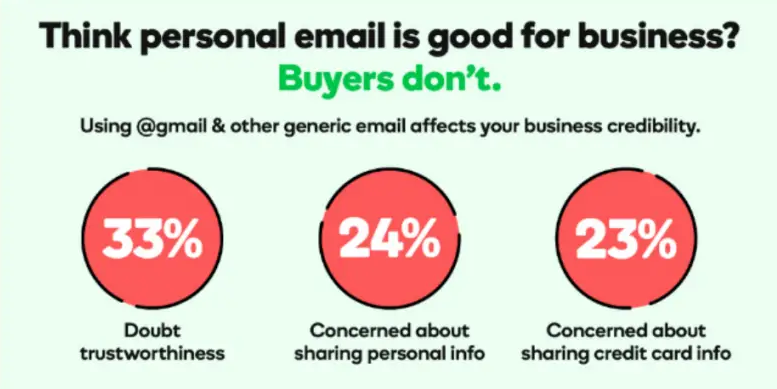Discover top guides, trends, tips and expertise from AIO Writers

You’re ready to take your business to the next level. You’ve got the skills, the drive, and the big ideas. But there’s just one problem – you’re still using that old college email address. Yikes.
It’s time for an upgrade. A shiny new business email address that screams “I’m a pro!” and makes a killer first impression. One that’s got your company’s name written all over it.
Switching to a business email address doesn’t have to be a headache. I’m here to make it a breeze with this easy-peasy, 5-step guide.
Let’s dive in and get your professional email address set up in no time!
Table Of Contents:
- How to Create a Business Email
- Tips for Writing Professional Business Emails
- FAQs: How to Create a Business Email
- Conclusion
How to Create a Business Email
Are you still using your personal Yahoo or Hotmail email address for your business communication?
Well, I hope not.
Having a dedicated professional email address is essential for maintaining credibility in your business emails.
When you use an email address that is associated with your business domain (such as yourname@yourcompany.com), it conveys a sense of legitimacy and trustworthiness to clients, customers, and business partners.
This professionalism is crucial in building strong relationships and projecting a reliable image for your business.

Let me show you how to create a business email in five easy steps.
Step 1: Choose a Business Email Service Provider
The first step in creating a business email address is selecting an email service provider. The choices are plentiful and varied, catering to a wide range of needs and preferences.
As a small business owner myself, I’ve tried my fair share of email providers. From free business email options like Zoho Mail to paid services like Google Workspace (formerly G Suite), I’ve seen it all.
Here’s the thing: while a free business email address might seem tempting, it’s not always the best choice. Free business email address providers often lack the features and support you need as your business grows.
Avoid the headache of subpar email hosting by opting for a reputable provider from day one. A custom domain will make you look like a pro, while ample storage ensures you’ll never run out of space. And with strong security features, you can rest easy knowing your emails are in good hands.
Personally, I’m a big fan of Google Workspace. It’s what I use for my business emails, and I love the seamless integration with other Google tools like Drive and Calendar.
But there are plenty of other great options out there, too. Some popular choices include:
- Bluehost (often bundled with their WordPress hosting plans)
- Microsoft 365 (formerly Office 365)
- Rackspace
As you compare email providers, consider the cost, storage capacity, and the number of email accounts allowed. To get a better understanding of each provider’s reputation and level of customer support, be sure to read through user reviews and explore relevant forums.
Here’s the deal: a premium email service provider is essential for creating a professional online image. Sure, it may require a slightly higher investment than a free business email service but the benefits – like robust features and dedicated support – are well worth it for your business.
Step 2: Register a Domain Name for Your Business Email
Want to know one of the biggest mistakes I see small businesses make with their business email addresses? Using a generic domain like gmail.com or yahoo.com.
Picture this: you’ve been using a Gmail account for your business communications, and it’s worked well enough so far. But now, you’re ready to take things to the next level. That’s where a custom domain comes in – it’s the secret ingredient that can help you build a strong, recognizable brand that people will remember.
Think about it: which email address looks more professional: john@yahoo.com or john@acmewidgets.com?
The latter, right?
Fortunately, registering a custom domain for your business emails is easier than you might think. Many domain registrars offer affordable options, and some email hosting providers even include a free domain with their plans.
When choosing a domain name, keep it short, memorable, and relevant to your business. Avoid hyphens, numbers, and unusual spellings that could confuse potential customers.
If your ideal domain name is already taken, consider adding a keyword or location to make it unique.
For example, if acmewidgets.com is unavailable, you could try acmewidgetsnyc.com or acmewidgetshop.com.
Once you’ve registered your domain, you’ll need to set up DNS records to point it to your email hosting provider. This might sound technical, but most providers offer step-by-step instructions or even handle the process for you.
Want to make a lasting impression with your business email address? Investing in a custom domain name is the way to go. It’s a small price to pay for a professional image that will take your business to the next level.
Step 3: Set Up Your Business Email Account
Alright, so you’ve chosen an email provider and registered a custom domain name. Now it’s time for the fun part: setting up your actual business email account.
Choose a Professional Email Address Format
First things first, let’s talk about email address formats. While you might be tempted to get creative here, I recommend keeping it simple and professional.
Here are some of the most widely email address formats:
- firstname@yourdomain.com
- firstname.lastname@yourdomain.com
- firstinitiallastname@yourdomain.com
Avoid using nicknames, numbers, or anything that could be seen as unprofessional. And if you have a common name, consider adding a middle initial to make your address unique.
Create a Strong Password
Your email account is the backbone of your business communications. Protect it from security risks by taking a few minutes to whip up a strong password that keeps the bad guys out.
When creating a password, use a mix of uppercase and lowercase letters, numbers, and special characters. Avoid using easily guessable information like birthdays or pet names.
I know it can be tempting to use the same password for multiple accounts but trust me, it’s not worth the risk. If one account gets hacked, all of your other accounts become vulnerable too.
Consider using a password manager like LastPass or 1Password to generate and store strong, unique passwords for all of your accounts.
Configure Your Email Client
You’ve made it to the last step – configuring your email client to communicate with your new business email address.
If you’re using a web-based client like Gmail or Outlook, simply add your new email address to your account settings and follow the prompts to set up incoming and outgoing mail servers.
If you prefer a desktop client like Apple Mail or Thunderbird, you’ll need to enter your email account details manually. Your email provider should provide the necessary server settings, or you can usually find them with a quick Google search.
Once your email address is set up, take some time to customize your settings and preferences. This might include creating signatures, setting up folders or labels to organize your messages, and adjusting notification settings.
And there you have it — your very own business email address ready to help you communicate professionally with clients and colleagues alike.
Step 4: Customize Your Business Email Settings
Now that you’ve got your business email address set up, it’s time to make it work for you. Most email service providers offer a control panel or dashboard where you can customize your business email settings.
Streamline your email experience by leveraging features like forwarding, creating targeted email accounts, and setting up filters to keep spam at bay.
Additionally, regularly monitor and manage your email storage to prevent any unwanted surprises down the road.
I’ve been setting up business email addresses for years, and I can tell you that taking the time to customize your settings is crucial.
Here’s what you should do:
- Log in to your email service provider’s control panel.
- Navigate to the settings or preferences section.
- Set up email forwarding if you want emails sent to another address.
- Create any additional email accounts you need for your team or departments.
- Adjust your spam filter settings to ensure important emails are delivered.
- Configure your email storage settings and set up any necessary archives.
Follow these steps to make your business email work overtime for you.
Plus, don’t sleep on the productivity tools that come standard with most email providers. Calendars keep you organized, task lists keep you focused, and integrations with your favorite apps keep everything running smoothly.
Step 5: Start Using Your Business Email for Professional Communication
You’ve got your professional email address set up and customized — now it’s time to put it to work.
Start using your professional email for all your business communications, whether you’re emailing clients, vendors, partners, or your own team.
I’ve been in the small business game long enough to know that details matter. Professional email addresses are a small but mighty way to show your clients you’re in it to win it. They lend an air of credibility that generic email providers just can’t match.
Also read: How to Format a Professional Email
Tips for Writing Professional Business Emails
Of course, it’s not just about having a professional business email address – you also need to make sure the content of your emails is top-notch.
Here are a few tips I’ve learned over the years:
- Keep your subject lines clear and concise.
- Use a professional greeting and sign-off.
- Keep your tone friendly but professional.
- Proofread every email before hitting send.
- Respond to emails promptly, even if it’s just to say you’ll reply in full later.
Using Your Business Email for Marketing
Alright, listen up – your business email? It’s not just some stuffy old tool for sending memos. Nah, it’s a full-blown email marketing machine.
You can use it to send out newsletters that’ll knock your customers’ socks off, promote sales that’ll have ’em lining up around the block, or just drop a friendly line to show ’em you care.
Email’s the ultimate way to connect with your people so don’t sleep on it.
Read our comprehensive guide on the different types of emails you should be sending your customers.
Just remember to follow best practices for email marketing, like getting permission before adding someone to your subscriber list, providing value in every email, and making it easy for people to unsubscribe if they want to.
Ready to take your business to the next level? Snag a professional business email address and dive into the world of email marketing. Before you know it, you’ll be creating a thriving business that’s the talk of the town.
FAQs: How to Create a Business Email
How do I create a business email address?
Pick a service, register your domain, and then set up a business email account. Choose a name that reflects your brand.
Is it free to create a business email?
Some companies provide free email addresses but you still need to pay for hosting and possibly the domain. Some providers offer deals, but totally free is rare.
What email should I create for a small business?
Your email should be professional and linked to your domain. Think “yourname@yourbusiness.com” for instant credibility.
How to start a business mail?
Select an easy-to-remember format like first.last@company.com, then use this across all professional communications.
Conclusion
And there you have it – your very own business email, all setup and ready to rock.
Now you’ve got an email that matches your brand, boosts your credibility, and helps you connect with clients and customers like a true pro.
But creating a business email is just the first step. To really make the most of it, you’ve got to use it strategically. That means crafting compelling subject lines, personalizing your messages, and always, always double-checking for typos.
Ready to show off your professional prowess? Start using that sleek new business email address and watch your career credibility skyrocket. You’ve got the tools – now it’s time to shine!

UNLOCK YOUR POTENTIAL
Long Headline that highlights Value Proposition of Lead Magnet
Grab a front row seat to our video masterclasses, interviews, case studies, tutorials, and guides.



